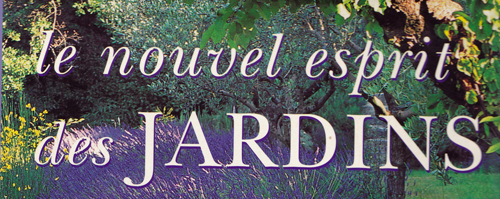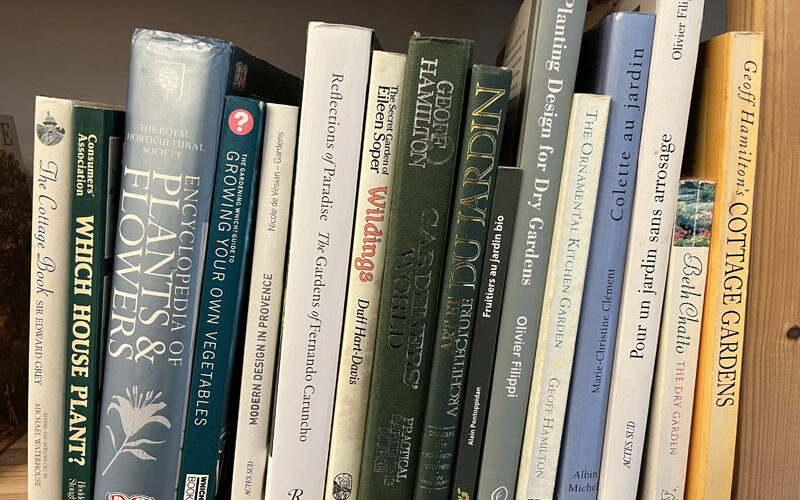Louisa Jones
Hachette Livres Pratiques 1998

Here is another sumptuous volume from Louisa Jones, illustrated once again by the inimitable photographs of Vincent Motte. M. Motte’s eye is so sure, his compositions so ravishing, that whether his subject matter is a compost heap, a magnificent old urn filled with tumbling plumbago or a wide view over a grand theatrical landscape, each garden seems vibrant on the page – all that is missing is its heady scent.
Louisa’s title Le nouvel esprit des Jardins is, perhaps, a misleading one. True, she is describing ten gardens which were created from scratch in the nineties. But what we are seeing today in many of the newer gardens of Provence is not so much a nouvel esprit, but the recapturing of the simpler methods of cultivation of long ago.
Landscape artists and garden lovers have fled the bondage of formalised Italian and French styles and rare or difficult plant varieties and instead are edging back to the use of indigenous plants which demand minimal attention. Out go the bright colours of traditional herbaceous borders and out go the exotics, save those of similar Mediterranean-climate zones in South Africa, Australia and California. In come the indigenous plants – lavender, rosemary, cinerarias, box, terebinth and of course olive trees, although they were originally brought to France by the Greeks.
The problems of finding, never mind affording, good labour, plus the serious lack of water, are increasingly crucial to gardeners here and have led amateurs and professionals alike to re-think their planting schemes to take account of these restrictions. Having said that, the majority of the gardens selected for this book have been designed by professionals with, apparently, scant regard for limited budget or labour.
Louisa’s thoughtful introduction invokes the age-old wisdom on the art of ‘husbandry’, handed down from the Greeks and Romans, the original cultivators of Provence. The three principles of the Romans, the ager, or worked ground, the saltus, or pasture, and the silva, or forest, are beginning to burgeon again here in Provence and are incorporated to some extent in the inspiration of these new gardens.
Louisa devotes a chapter to each selected garden, from Grasse in the Alpes-Maritimes, to the Luberon and the Vaucluse. I particularly enjoyed the plans with their numbered keys, making it much easier to understand the layout of the whole landscape which cannot always be appreciated in photographs or even in words. It would have been helpful to have a compass orientation on each plan.
A perennial problem when describing gardens is that it is easy to become repetitive. Take, for example, a garden of rare beauty near Grasse, designed by our friend, Jean Mus. M. Mus’s intimate knowledge of local plants, combined with his sure eye for symmetry, has produced a happy marriage of classic and traditional styles. If Louisa’s description here is slightly repetitive, it is surely because M. Mus’s planting themes often repeat themselves. But then this is one very good reason why his gardens are so satisfactorily coherent, calm and complete.
This repetition occurs again in the description of Nicole de Vésian’s garden, La Louve, one that has been quoted and photographed many, many times and, therefore, barely needs introduction. Although I have never visited it, I have always admired it from photographs. But in reality, unless you are a poet, there is only so much that can be said in words about the repeated use of stones and plants taken from, or inspired by, the local hillsides, even if the overall result is glorious. There is also an account of another de Vésian garden in the Luberon, a happy combination of ancient walls and buildings, with regional wild plants subtly tamed by judicious pruning.
The most astonishing garden is that designed for Pierre Bergé by Michel Semini, which took just six months to create. It is marvellously theatrical and packed with Provençal specialities but, for me, it is more like a stage-set than a garden. Louisa shows us what can be done with a great deal of money but the result is instant gardening which few of us can envisage.
Bolder still, cold-looking yet designed for summer heat, is landscape architect Peter Klausen’s minimalist creation. To my eye, the stark white walls shock. I find it uncomfortable, uncompromising, and only where the planches are allowed to fall away unadorned, throwing into sharp focus the wizened trunks of old olive trees, does this property become restful. Not so much gardening, as architecture.
The most satisfactory gardens are those where the plants seem comfortable as they grow. Take the garden of Mme. H, who has created a landscape of great charm near the sea, blending plants such as lavenders and salvias into a rustic background. She has had the benefit of guidance from Pierre Quillier, celebrated for his fine achievements at the Noailles garden at Hyères. It is sensitive and humorous, with its Buxus sheep eating the lawn and a large heron-shaped teucrium.
Or consider the garden of Helen Hamlyn, a designer of no mean quality. This plot truly captures the ‘feel’ of the Mediterranean, with its 900 olive trees which have determined the development of the garden in keeping with the ancients agers or working fields. Judas trees, lavenders, rosemary and other indigenous plants thrive here along with rampant climbers soaring up among the olives. The overall effect is of nature untrammelled, which makes it one of the most charming gardens in the book and, possibly, the least labour intensive.
The family garden south of Avignon by designers Dominique Lafourcade and David Milanese is full of lovely shapes and clever use of ‘verticals’. Another small chateau garden with a view towards Mont Ventoux has been so cleverly designed by Alain Idoux that it looks completely natural, as if it had just ‘growed’. This garden has had the great good fortune to have its plant choice overseen by Olivier Filippi.
Especially useful are the notes at the end of the book listing garden designers and landscapers, nurseries specialising in Mediterranean plants and a bibliography. Everyone who reads this book will have their favourites and each example has plenty to inspire us which can be adapted to our own gardens and pockets. Louisa’s botanical knowledge is prodigious and she gives very detailed descriptions of the plants in each garden, and thanks to Vincent Motte, her book is also a feast for the eyes.
Review by Joanna Millar – Mediterranean Gardening France

